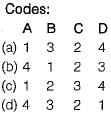Test: Direct Current Machine of Electrical Machines - Electrical Engineering (EE) MCQ
10 Questions MCQ Test - Test: Direct Current Machine of Electrical Machines
Consider the following statements about the field windings used for various types of dc machines:
1. For dc shunt machines, large number of turns of small cross-section are used.
2. For dc series machine, small number of turns of large cross-section are used.
3. For dc compound machine, both shunt (thick wire) and series (thin wire) field windings are used.
Out of the above statements the correct statements is/are:
1. For dc shunt machines, large number of turns of small cross-section are used.
2. For dc series machine, small number of turns of large cross-section are used.
3. For dc compound machine, both shunt (thick wire) and series (thin wire) field windings are used.
Out of the above statements the correct statements is/are:
A 6-pole DC machine with lap winding has 300 conductors and a flux per pole of 15 mWb. If the machine is driven at 1800 rpm, then the average EMF induced per conductor will be:
A commutator with a diameter of 50 cm rotates at 1000 rpm. For a brush width of 1.5 cm, the time of commutation is
A 24 kW, 250 V, 1600 rpm separately-excited d.c. generator has armature circuit resistance of 0.1Ω. The machine is first run at rated speed and the field winding current is adjusted to give an open circuit voltage of 260 V. Now, when the generator is loaded to deliver its rated current, the speed of the driving motor is found to be 1500 r.p.m. Assuming flux to remain constant, the terminal voltage of the generator under these conditions is
Assertion (A): DC series motors are suitable for buses, trolleys, hoists and trains.
Reason (R): DC series motors are variable Speed motors.
Assertion (A): Armature resistance control method of speed control of dc motors is wasteful and inefficient.
Reason (R): Large amount of power is wasted in the control resistances, specially in case of shunt motors'.
Match List-I (Tests on DC machines) with
List-ll (Results) and select the correct answer using the codes given below the lists:
List-I
A. Field test
B. Swinburne’s test
C. Hopkinson test
D. Retardation test
List-II
1. Stray losses in case of dc series machines
2. Constant losses
3. Performance of machines regarding commutation and temperature rise
4. Stray losses in case of dc shunt machines

At a certain speed and flux, the voltage generated by a dc generator is 230 volts. If the speed is increased by 20% and the flux is simultaneously reduced by 10%, the voltage generated will be
LAP winding is employed in a dc machine of
Consider the following parts of a dc machine:
1. Pole core
2. Brushes
3. Yoke
4. Armature core
Which of the above parts are not subjected to iron loss?
























